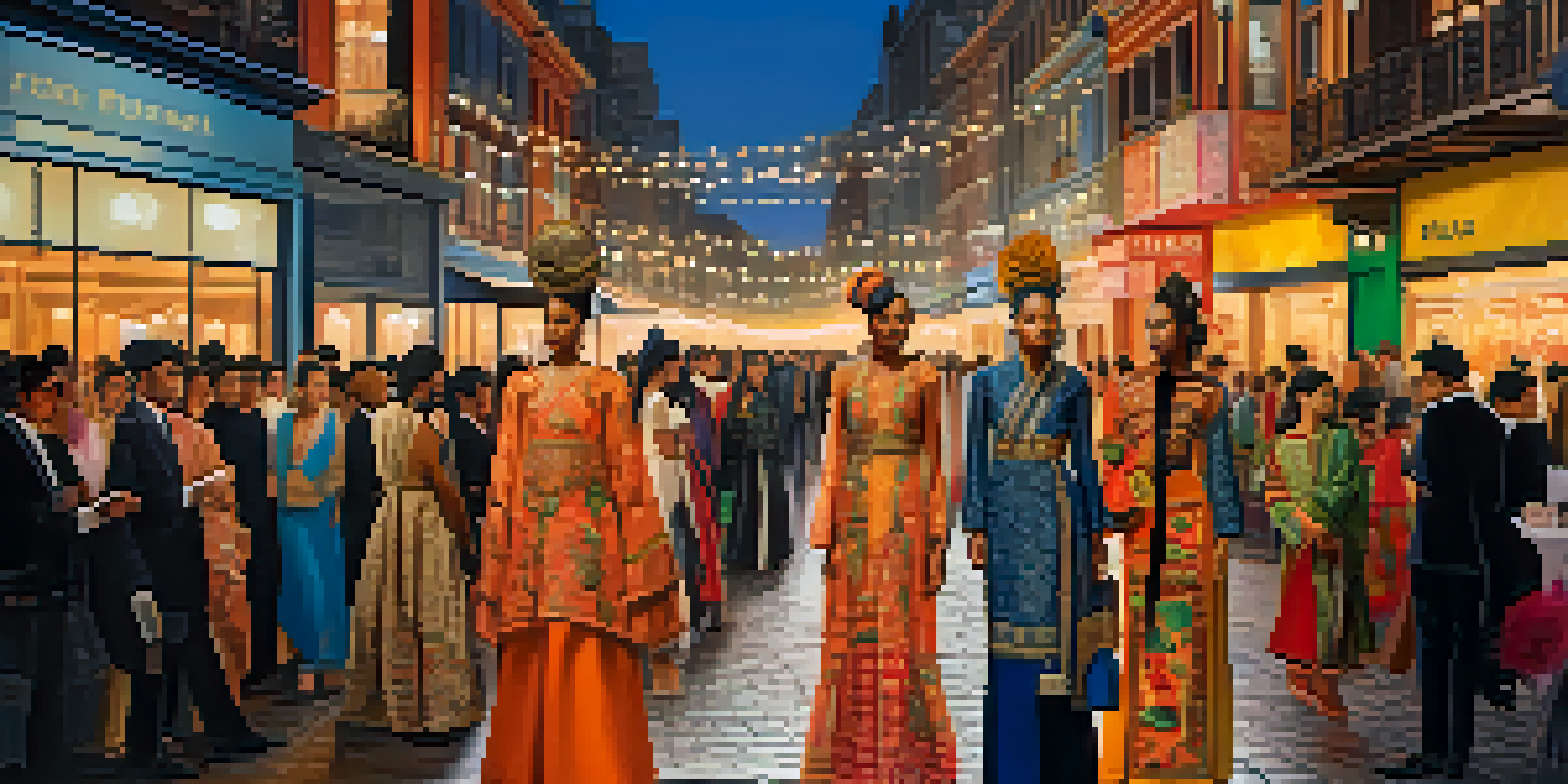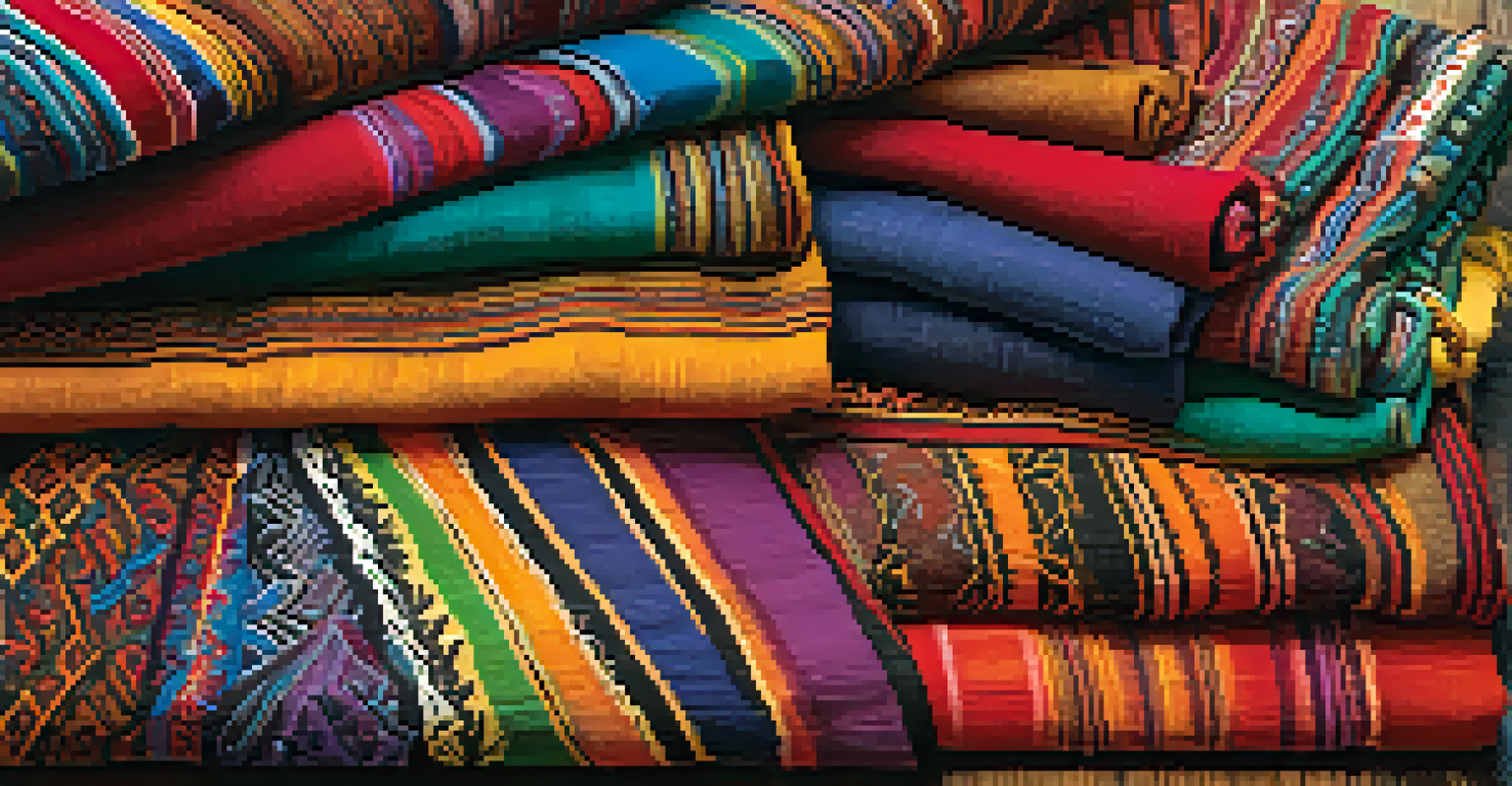The Role of Fashion in Preserving Cultural Heritage Globally

Fashion as a Reflection of Cultural Identity
Fashion is much more than clothing; it embodies the unique identity of different cultures. Each garment tells a story, often reflecting the history, beliefs, and values of its people. For instance, traditional attire like the kimono in Japan or the sari in India showcases not only fabric and design but also deep-rooted cultural narratives.
Fashion is the armor to survive the reality of everyday life.
As societies evolve, so does fashion, yet traditional styles often remain a powerful symbol of heritage. When individuals wear these garments, they connect with their ancestors and express pride in their cultural roots. This act of wearing traditional fashion can strengthen community ties and promote understanding among diverse groups.
Fashion therefore acts as a living testament to cultural identity. By celebrating and wearing traditional clothing, people contribute to the preservation of their heritage, ensuring that future generations can appreciate and learn about their cultural history.
The Role of Textiles in Cultural Heritage
Textiles play a crucial role in cultural heritage, often serving as the foundation for traditional fashion. Different regions are known for their unique textiles, from the intricate weavings of Guatemalan artisans to the vibrant batiks of Indonesia. These materials are not just practical; they carry methods and stories passed down through generations.

Moreover, the techniques used to create these textiles often reflect the environment and resources of the area, adding a layer of sustainability to cultural practices. By preserving traditional textile-making methods, communities keep their heritage alive while also promoting eco-friendly practices.
Fashion Reflects Cultural Identity
Fashion serves as a powerful expression of cultural identity, showcasing the history and values of diverse communities.
In this way, textiles become a bridge between the past and present. They provide insight into a culture's history and values, ensuring that the artistry and craftsmanship are respected and celebrated.
Fashion Weeks: A Global Stage for Cultural Expression
Fashion weeks around the world have become vital platforms for showcasing cultural heritage. Designers often draw inspiration from their roots, blending traditional motifs with contemporary styles. Events like Paris Fashion Week or New York Fashion Week highlight this fusion, allowing diverse cultures to share their stories on a global stage.
Clothes mean nothing until someone lives in them.
For example, designers like Stella Jean incorporate elements from their heritage into modern fashion, showcasing how cultural influences can coexist and thrive. This not only promotes cultural appreciation but also encourages dialogue about identity and heritage among attendees from various backgrounds.
By participating in these high-profile events, designers help to preserve and celebrate their cultural narratives, inspiring others to explore and appreciate the richness of global fashion traditions.
The Influence of Social Media on Cultural Fashion
Social media has revolutionized how fashion and culture interact, enabling wider access to diverse styles and traditions. Platforms like Instagram and TikTok allow users to showcase their heritage through fashion, creating a vibrant tapestry of global influences. This democratization of fashion helps amplify voices that might otherwise go unheard.
Moreover, social media fosters a sense of community among individuals who share similar cultural backgrounds. Hashtags like #CulturalFashion encourage users to celebrate their heritage through their clothing choices, creating a shared experience that transcends geographical boundaries.
Textiles Preserve Cultural Heritage
Textiles are essential in maintaining cultural heritage, encapsulating traditional methods and stories passed through generations.
As a result, social media not only preserves cultural heritage but also redefines it. It allows for a dynamic exchange of ideas, ensuring that traditional fashion remains relevant in today's fast-paced world.
The Impact of Globalization on Cultural Fashion
Globalization has brought about significant changes in fashion, often blending traditional styles with contemporary trends. While this fusion can be beneficial, it also poses challenges for cultural preservation. As Western fashion dominates the global market, traditional garments risk being overshadowed or commercialized, losing their original significance.
However, globalization also presents an opportunity for cultural exchange. Many designers are now reinterpreting traditional styles, creating new designs that honor their heritage while appealing to a broader audience. This balance can help maintain the relevance of cultural fashion in an ever-evolving landscape.
Ultimately, the challenge lies in navigating this globalized world while remaining true to cultural roots. By promoting awareness and appreciation for traditional styles, we can ensure that cultural fashion continues to thrive.
The Role of Education in Cultural Fashion Preservation
Education plays a vital role in preserving cultural heritage through fashion. Schools and institutions can teach students about the significance of traditional garments, fostering a deeper appreciation for their cultural roots. By integrating cultural studies into fashion education, future designers can be inspired to honor and incorporate traditional elements.
Workshops and community programs that focus on traditional textile arts, for instance, can empower individuals to learn these skills. As they engage with their heritage, they not only preserve these practices but also pass them on to the next generation, ensuring the continuity of cultural knowledge.
Social Media Amplifies Cultural Fashion
Social media platforms enable the sharing and celebration of cultural fashion, fostering global connections and community.
In this way, education becomes a powerful tool for cultural preservation. By equipping individuals with the knowledge and skills to celebrate their heritage, we nurture a sense of pride and responsibility towards their cultural identity.
Fashion as a Tool for Cultural Diplomacy
Fashion has emerged as a unique tool for cultural diplomacy, fostering understanding between nations. Through fashion exhibitions and cultural exchange programs, countries can showcase their heritage and build connections with others. This diplomatic approach allows for a deeper appreciation of diverse cultures, promoting peace and collaboration.
For example, initiatives like the 'Fashion for Peace' movement emphasize how fashion can unite people across borders, highlighting shared values and traditions. By showcasing traditional garments alongside contemporary designs, these initiatives celebrate the richness of cultural diversity.

As nations recognize the power of fashion in diplomacy, we can expect to see more collaborations that promote cultural heritage. This not only enriches global fashion but also cultivates mutual respect and understanding among diverse communities.